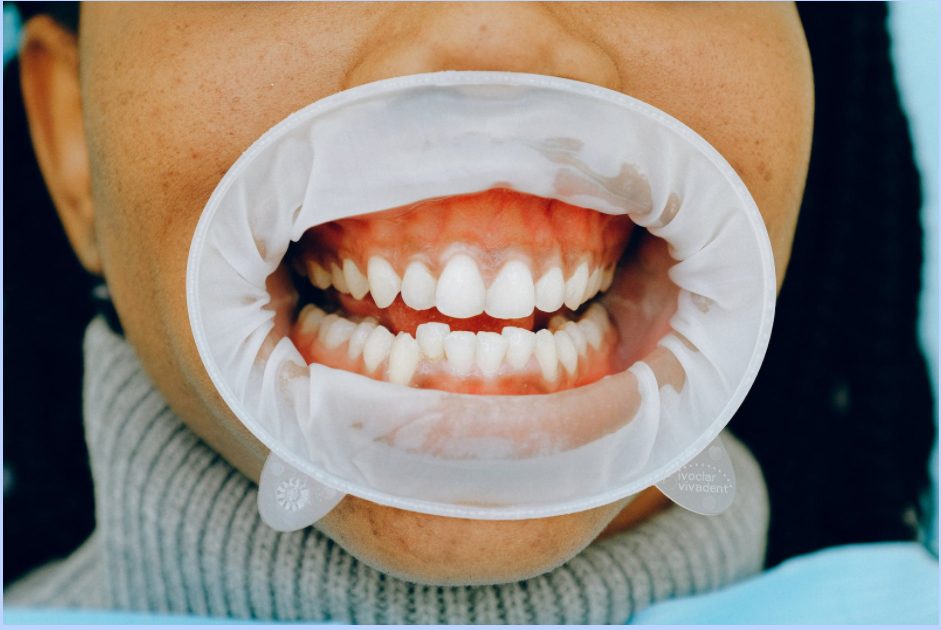You may be slightly concerned if you have white stuff on your gums. This is normal and understandable, but there are things that you can do to try and make yourself much more comfortable.

What is this White Stuff?
If you’ve ever asked the internet, “Why are my gums white?” “What’s the white stuff on my gums?” or “white stuff after brushing teeth,” you’re not alone. White dots on gums, a white substance in mouth, or a white line on gums below teeth may be a cause for concern.
White spots on your gums may be in the form of patches, or you might have small spots or a white dot on your gums. On the other hand, you may notice that the white stuff is in a lace-like web. The white stuff may be thick and leave white stringy stuff in mouth, or it may be painful. You may even have white stuff on teeth near gums. White spots on your gums can indicate a mild health issue that may resolve on its own, or it may be a much more serious indicator of something wrong, like oral cancer cases.
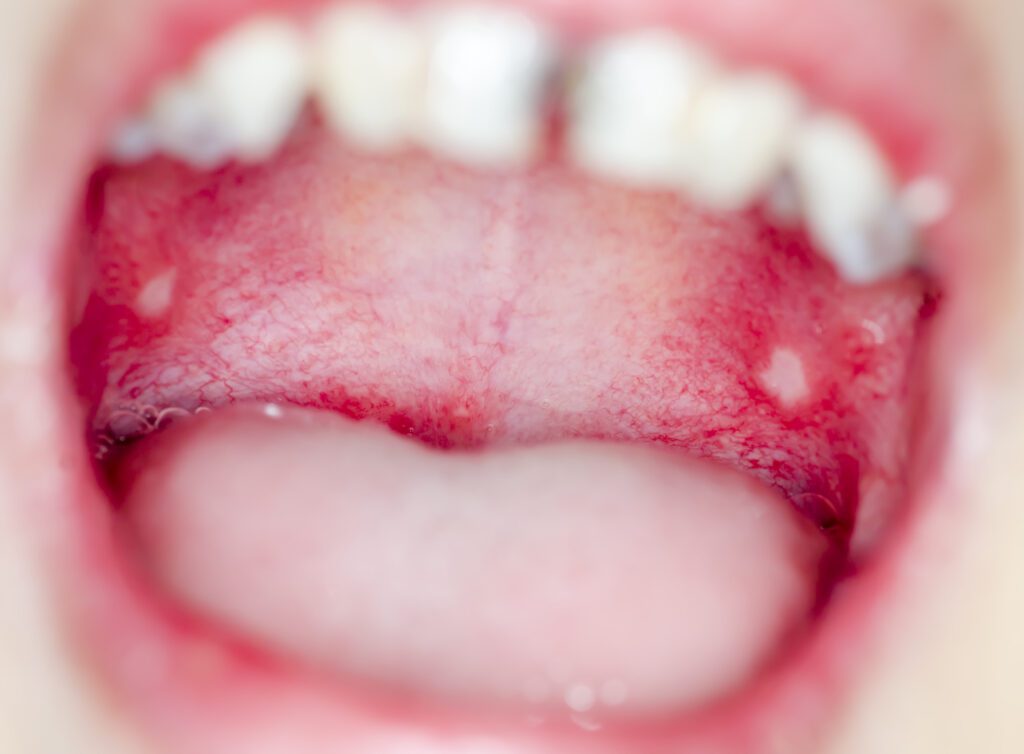
Common Symptoms that Accompany White Gums
There are typically a few other symptoms present when you have white gums. These may include:
White Crust Around Mouth
Sometimes, white spots on the gums can spread, leading to a white crust around the mouth. This may be due to dryness, dehydration, lip licking, certain medications, or skin conditions like eczema or psoriasis. You should consult with a healthcare professional if you notice this symptom.
White Gums After Dental Work
If you’ve recently had dental work done, such as tooth extraction or gum surgery, it’s not uncommon to notice white gums in the area where the procedure was performed. This is usually a sign of healing, as the body produces a white blood clot to protect the wound. However, if the whiteness persists or is accompanied by pain or swelling, it might indicate an infection, and you should contact your dentist.
White Line Across Gums
A white line across the gums can signify oral lichen planus or Leukoplakia, both mentioned above. It can also be a sign of linea alba, a harmless white line that can form on the inside of the cheek along the bite line. The usual cause of this is the cheek rubbing against the teeth.
White Marks on Teeth Near Gums
White marks on your teeth near your gums could be a sign of dental fluorosis, which is caused by excessive fluoride intake during tooth development. These spots are often faint and barely noticeable. They could also be an indication of enamel hypoplasia. This condition occurs when there’s insufficient enamel on a tooth, leading to white spots.
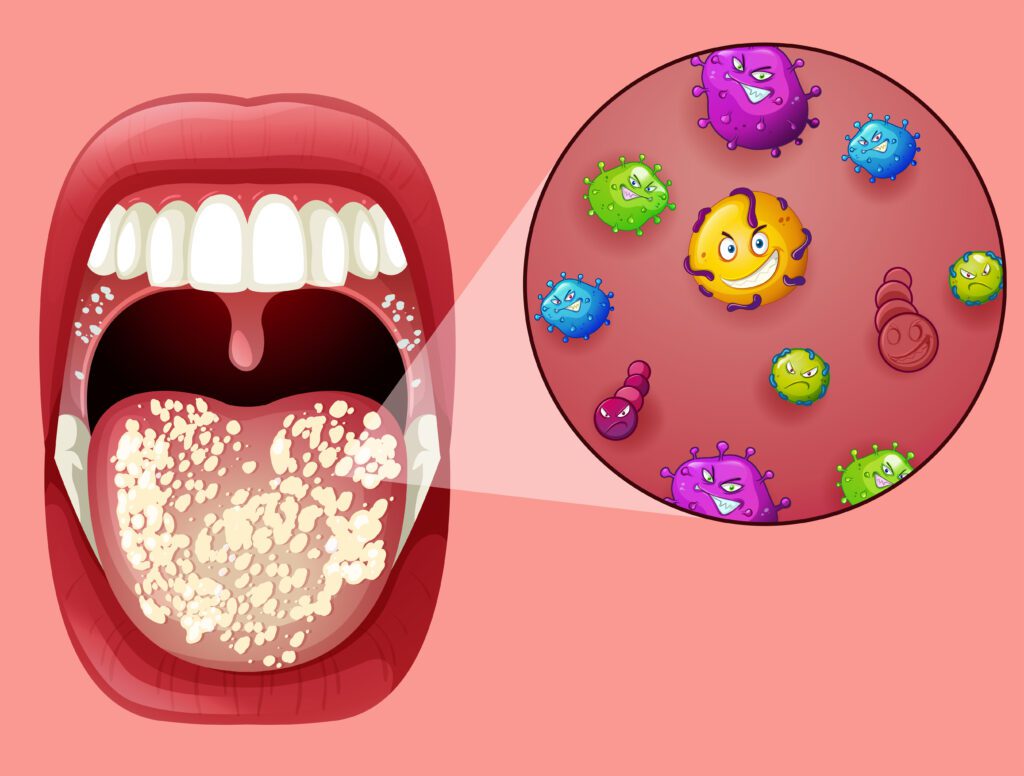
Causes of White Spots on Gums
There are many causes of white spots on your gums, with or without poor oral hygiene. Some of these can be found below.
Canker Sores
Canker sores are one of the leading causes of white spots on your gums. These mouth sores typically start out as red spots and may have a yellow or white spot right in the middle. Major canker sores, larger and deeper than minor mouth ulcers, often last two weeks or more and can be extremely painful. A stinging pain frequently accompanies canker sores. It’s very possible for this to become aggravated when you drink or eat, especially if it is acidic.
Thrush
Oral thrush is a fungal infection caused by the overgrowth of naturally occurring yeast in the sensitive mouth tissues called Candida fungus, and it gathers in a specific area of the mouth. You may notice creamy white or even yellow lesions on your gums, the roof of your mouth, or your inside cheek. You may have white gums around tooth or white sticky stuff on your teeth. The lesions may be raised, and they can cause you sore gums and very minor bleeding.
Oral Lichen Planus
Oral Lichen Planus can present as lacey patches on the gums or the mucus membranes around the mouth. This white patch on gum is an inflammatory condition. Although you may not experience gum pain, you may find that this develops into red or raised patches and open sores. This can cause symptoms and discomfort in general.
Leukoplakia
Leukoplakia is a small white patch that may appear on your gums or the bottom of your mouth. It’s also possible for it to appear on the inside of your cheeks. The patches may thicken or harden over time, and cannot be scraped off. Many cases of this condition are benign, but some may be precancerous. Speckled patches, or white patches with some redder areas, are much more likely to be precancerous.
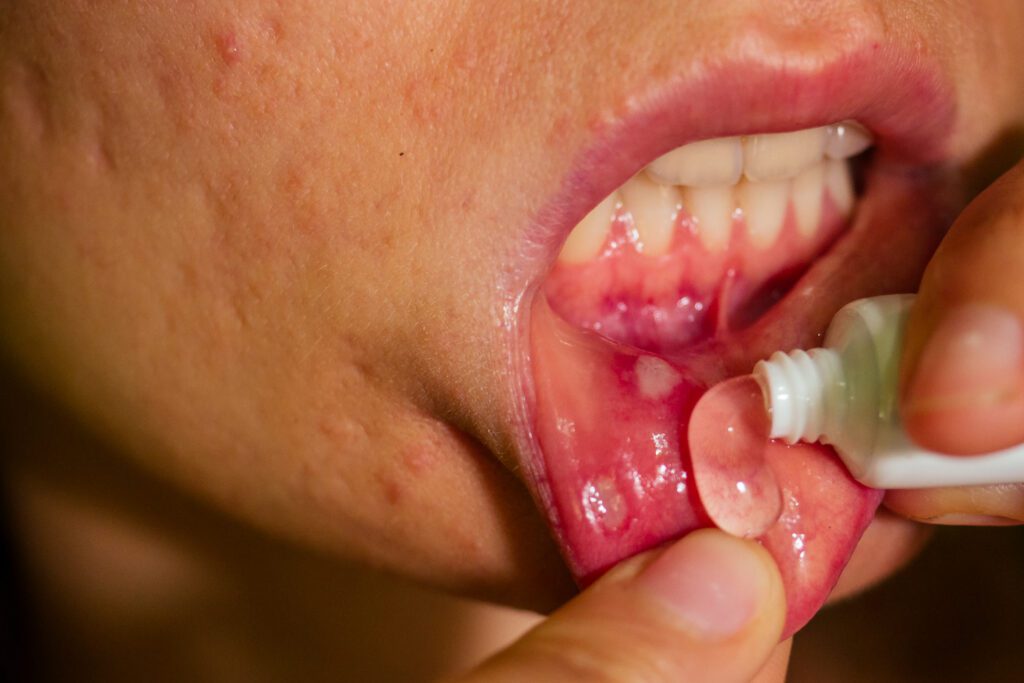
Common Symptoms
So now you know the things you need to look out for; it’s time to delve into the symptoms of white spots on my gums. Various symptoms can accompany white spots on your gums. The symptoms accompanying the white film in your mouth, white dots on gums, or white gummy stuff in your mouth can vary depending on the cause:
Canker Sores
Canker sores, for example, tend to be very small, and they are either yellow or white spots on gums that hurt. The border is usually red in color. Other symptoms of major canker sores include a burning sensation or stinging, which may occur before the sore appears. They typically occur independently, but seeing them in clusters is not uncommon. Spicy or acidic foods may cause more pain.
Oral Thrush
Oral thrush lesions can have a cottage cheese appearance and may be raised. You may also experience cracking or bleeding if the area is especially irritated. Loss of taste and having a cotton-like feeling in your mouth is also very common.
Oral Lichen Planus
With oral lichen planus, you will have lacey raised patches, which can develop into red raised patches. Some symptoms can include burning sensations, sensitivity to hot or acidic foods, and bleeding. You may also experience inflammation of the gums and thickened patches on the tongue.
Leukoplakia
Leukoplakia causes white or gray patches on the mouth that can thicken or harden. It isn’t painful and can often go undetected for this reason. If you have very severe symptoms, you may experience discomfort, ear pain when you swallow, or even the inability to open your mouth properly.
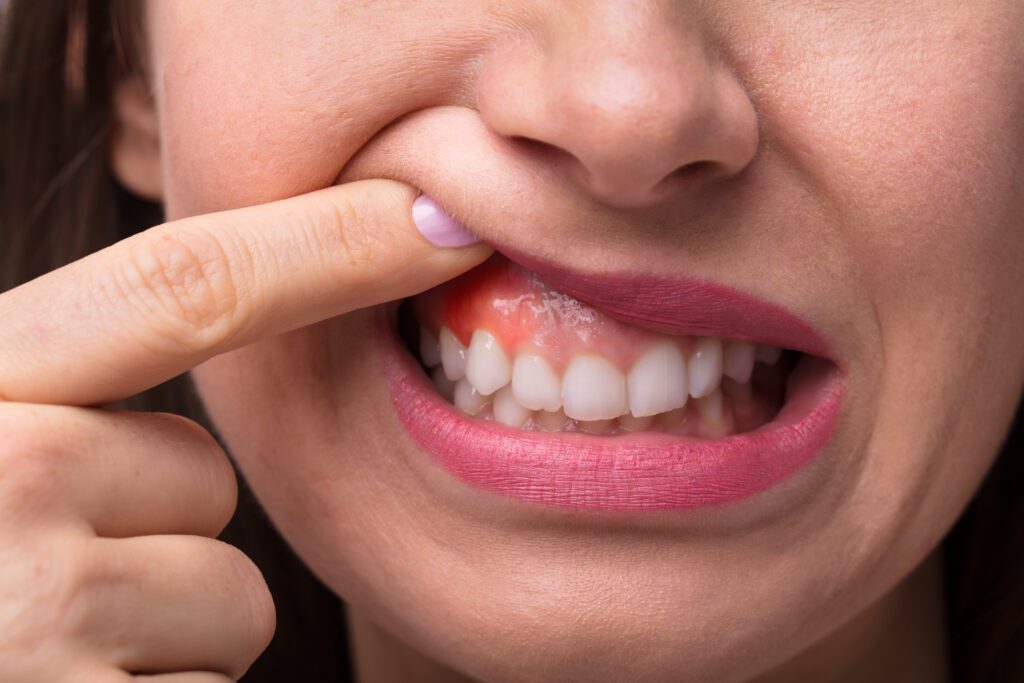
Treating the White Film on Inside of Lips and Mouth
The treatment for the white gunk in your mouth largely depends on its cause. If you want to seek the proper treatment, then look below.
Canker Sores
Minor canker sores will resolve on their own in a week. You may also want to use a mouth rinse or another topical product. It may also help you to use products that contain lidocaine. You can also make a paste of baking soda and water to put on the sore. Ask your dentist for advice if you have several severe sores or others that keep coming back.
Oral Thrush
The treatment for oral thrush would usually be an antifungal medication. This can be in a tablet form, or it can be in the form of a lozenge. You can also get a liquid version that you drink straight. Sometimes, your doctor or dentist may prescribe an antifungal mouthwash.
Oral Lichen Planus
Oral lichen planus treatment may include using corticosteroids to reduce any inflammation. These can be injectable, topical, or oral. You may also get some pain relief from these treatments. Other treatments for oral lichen planus include antihistamines and antidepressants.
Leukoplakia
You may need to have your Leukoplakia tested to ensure it is not precancerous. Your dentist will most likely take a biopsy and ensure it is safe to remove. When this has been done, your dentist will remove the Leukoplakia with a scalpel or a laser. This will freeze or destroy any cells. You will, of course, be numbed before it is extracted. Treatment for Leukoplakia may also include quitting smoking or avoiding other irritants.
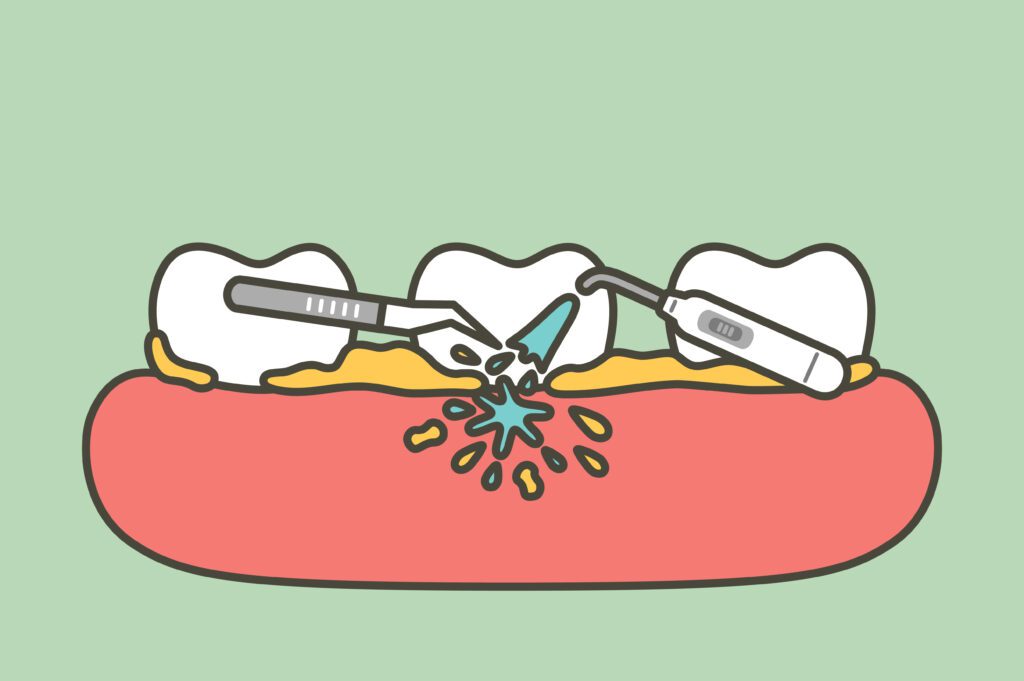
How to Prevent Oral Lesions and White Spots
If you want to try to stop any white spots or lesions from occurring or coming back, you need to ensure that you maintain good oral hygiene. You also need to make sure that you do everything you can to attend regular dentist appointments, including routine dental cleanings and deep dental cleanings, if your dental hygienist advises. To prevent a white buildup on teeth and white lines on gums, brush your teeth after meals and brush your tongue with a soft or medium toothbrush and a good fluoride toothpaste. Cleaning your tongue with a scraper can help you out quite a lot here.
Remember, oral thrush thrives in a dark and damp environment. Therefore, keeping your mouth clean can help prevent this fungal infection and prevent tooth decay. Your dental health is worth it!
It may also be wise to avoid using toothpaste and mouthwashes that contain sodium lauryl sulfate. Use a mouth rinse that includes sodium lauryl sulfate and is alcohol-free instead. Remember that stress can aggravate your immune system, too. If you need additional help, make sure that you contact your dentist to see if they can give you the help and support you need for your oral health and stop any whitening of the gums or mouth.
